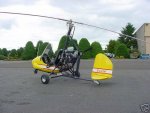dabkb2
Dave Bacon
- Joined
- Sep 26, 2005
- Messages
- 2,787
- Location
- Vista, Ca
- Aircraft
- Sport Copter Vortex 582, 2 KB2 90Mac KB3 582
- Total Flight Time
- 529 hours
Tina and I brought are gyro's to Hemet airport last week. The only time I have at an airport was in my training with Charlie Mara, and he did all the radio work. I have 96 hours in a gyro so I think I am ready for it but it is a little more complicated than just flying around the desert, not to mention that my mic did not work. I could hear but not transmit, Tina did a good job letting the other pilots know what I was doing but it is not good ,not to be able to talk to the other pilots in the pattern. I am getting my radio fixed and think I will really like flying at an airport, but there is something to be said for the freedom of flying at El Mirage

